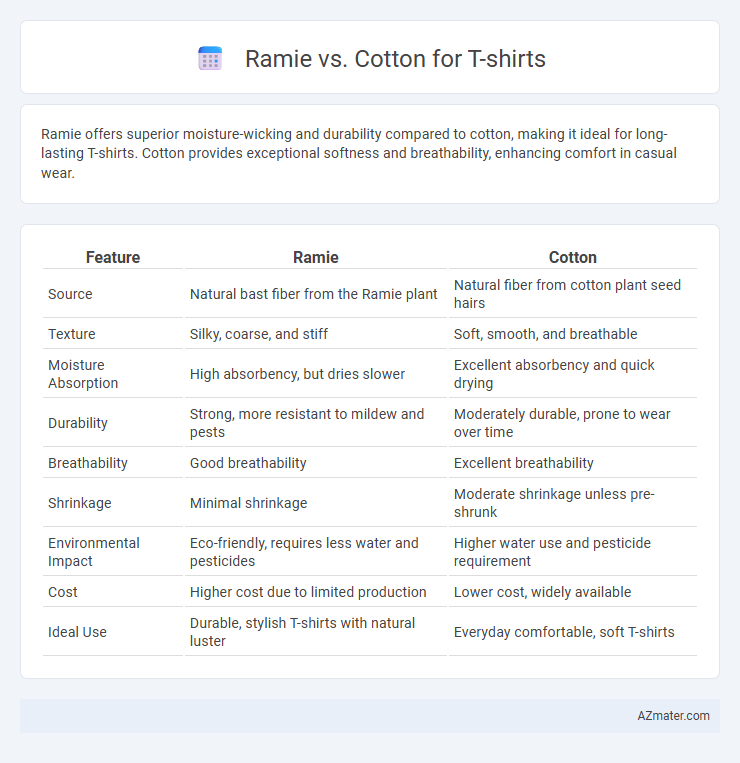Ramie offers superior moisture-wicking and durability compared to cotton, making it ideal for long-lasting T-shirts. Cotton provides exceptional softness and breathability, enhancing comfort in casual wear.
Table of Comparison
| Feature | Ramie | Cotton |
|---|---|---|
| Source | Natural bast fiber from the Ramie plant | Natural fiber from cotton plant seed hairs |
| Texture | Silky, coarse, and stiff | Soft, smooth, and breathable |
| Moisture Absorption | High absorbency, but dries slower | Excellent absorbency and quick drying |
| Durability | Strong, more resistant to mildew and pests | Moderately durable, prone to wear over time |
| Breathability | Good breathability | Excellent breathability |
| Shrinkage | Minimal shrinkage | Moderate shrinkage unless pre-shrunk |
| Environmental Impact | Eco-friendly, requires less water and pesticides | Higher water use and pesticide requirement |
| Cost | Higher cost due to limited production | Lower cost, widely available |
| Ideal Use | Durable, stylish T-shirts with natural luster | Everyday comfortable, soft T-shirts |
Introduction to Ramie and Cotton Fabrics
Ramie, a natural fiber derived from the stalks of the Chinese grass plant, offers exceptional strength and breathability for T-shirts, making it a durable and eco-friendly alternative to traditional fabrics. Cotton, widely cultivated and known for its softness and moisture-absorbing properties, remains a popular choice for comfortable and breathable T-shirt materials. Comparing ramie and cotton highlights ramie's lustrous sheen and mildew resistance against cotton's widespread availability and ease of care.
Botanical Origins and Production Processes
Ramie, derived from the stalks of the Boehmeria nivea plant native to East Asia, undergoes a labor-intensive retting and degumming process to extract its long, lustrous fibers, unlike cotton, which is harvested from the seed hairs of the Gossypium plant and processed through ginning to separate fibers from seeds. Ramie's mechanical extraction preserves its natural strength and sheen, while cotton fibers are shorter and require carding and combing for softness and durability in T-shirts. The botanical origin influences fiber properties, with ramie offering exceptional breathability and moisture-wicking, and cotton providing softness and ease of dyeing.
Texture and Feel: Ramie vs Cotton
Ramie fabric offers a crisp, smooth texture with a slight stiffness, providing a more lustrous and lightweight feel compared to cotton. Cotton is known for its soft, breathable, and flexible texture, making t-shirts comfortable and ideal for everyday wear. Ramie tends to feel cooler and less stretchy, while cotton delivers a gentle softness that molds easily to the body.
Durability and Longevity Comparison
Ramie fibers exhibit exceptional durability, being three to four times stronger than cotton, making them highly resistant to wear and tear in T-shirts. Cotton, while softer and more breathable, tends to degrade faster with repeated washing and exposure to sunlight, affecting its longevity. Choosing Ramie for T-shirts ensures extended fabric life due to its high tensile strength and resistance to mildew and shrinkage.
Breathability and Comfort Insights
Ramie fabric offers superior breathability compared to cotton, allowing better air circulation and moisture absorption, which keeps the skin cooler and drier during wear. Cotton is widely favored for its soft texture and natural comfort, but it tends to retain moisture longer, potentially reducing breathability in hot conditions. Ramie's durability combined with its lightweight nature makes it a comfortable alternative for T-shirts, especially in warm climates where enhanced ventilation is essential.
Moisture Absorption and Quick-Drying Abilities
Ramie fibers exhibit superior moisture absorption compared to cotton, absorbing nearly 35% of their weight in moisture without feeling damp, which enhances comfort in active wear. Cotton fibers absorb moisture at a similar rate but tend to retain water longer, leading to slower drying times. The quick-drying properties of ramie make it an ideal choice for T-shirts designed for high humidity or intense physical activity.
Environmental Impact and Sustainability
Ramie fibers are significantly more sustainable than cotton, requiring much less water and pesticides during cultivation, which reduces environmental degradation and promotes biodiversity. Cotton production often involves intensive water use and chemical fertilizers, contributing to soil depletion and water pollution, whereas ramie crops thrive with fewer inputs and enhance soil health. Choosing ramie for T-shirts supports eco-friendly textile practices by minimizing carbon footprint and conserving natural resources.
Maintenance and Care Requirements
Ramie fabric requires gentle washing and air drying to maintain its strength and avoid shrinkage, as it is prone to wrinkles and can become brittle with excessive heat exposure. Cotton T-shirts are easier to care for, tolerating machine washing and tumble drying, although they may shrink if exposed to high temperatures. Both fibers benefit from ironing at moderate heat, but cotton is generally more durable under regular maintenance routines.
Style and Dyeing Capabilities
Ramie fabric boasts a lustrous appearance and offers superior dye absorption, resulting in vibrant and long-lasting colors for T-shirts. Cotton provides a soft, matte finish with excellent breathability, allowing for natural, comfortable wear and good dye retention, especially with reactive dyes. While ramie enhances brightness and crispness in prints, cotton supports a wider range of dyeing techniques and offers greater versatility in style preferences.
Price Differences and Market Availability
Ramie t-shirts typically cost more than cotton due to the labor-intensive extraction process and lower global production volume, with average prices ranging from 15% to 30% higher than cotton counterparts. Cotton, widely cultivated and commercially dominant, offers extensive market availability and a variety of price points, making it more accessible for mass-market and budget-friendly t-shirts. Ramie's limited supply and niche demand restrict its presence mainly to premium or eco-friendly brands, whereas cotton dominates mainstream fashion markets worldwide.

Infographic: Ramie vs Cotton for T-shirt
 azmater.com
azmater.com